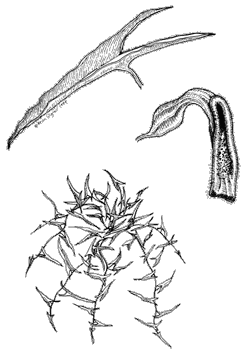Aristolochiaceae (pipevine family)
This is a tropical family of 400 species in the world, 300 of which are in the genus Aristolochia. They are mostly vines with strangely-shaped flowers and foliage that exudes a distinctive, unpleasant odor. Only a single species occurs in the Sonoran Desert.
Aristolochia watsonii
English names: Southwestern pipevine, snakeroot, birthwort
Spanish names: hierba del indio (Indian herb), guaco
 |
Description
A trailing or climbing vine with stems up to 3 feet (0.9 m) long. The 1 inch (2.5 cm) long, arrow-shaped leaves are usually dark brownish-green when growing in full sun. The tubular-funnel form flowers are about 1¼ inches (3.8 cm) long, green with brown spotting.
Flowering
Throughout the warm months.
Range
Aristolochia watsonii grows from Southern Arizona and adjacent Mexico to the tip of Baja California.
Notes
Though this species is inconspicuous and rarely encountered unless actively sought, it is included here because of three fascinating ecological stories.
One story is its pollination. Most pipevines are pollinated by deceiving insects into visiting the flowers; no reward is available. Usually the flowers smell like carrion or dung to attract insects that are seeking a place to lay eggs. The story of our species is even more remarkable. It is pollinated by Ceratopogonid flies; these are the small, blood-sucking flies that pester humans and other mammals in the humid summer. The flowers of Aristolochia watsonii resemble a mouse’s ear—translucent funnels with fur and veins—and give off a musty odor. The fly apparently expects to find a blood meal, and instead is trapped inside the flower tube overnight. During the night the flower releases pollen. The following morning the flower releases the pollen-covered fly. If the fly visits another flower it effects pollination.
All pipevines contain a variety of powerful toxins that humans have used for medicines. The name birthwort comes from its use during difficult births; it stimulates expulsion of the fetus and placenta.
The plant has also been used to treat snakebite, paralysis, malaria, impotence, intestinal worms, and infections. Though pipevine seems to be effective for numerous ailments, the side effects are horrific.
Despite the virulent toxins, pipevines are the larval food plant of the pipevine swallowtail, a large, showy butterfly. The caterpillars are black or red with red tubercles and grow to about 3 inches (7.6 cm) long. This conspicuous coloration warns potential predators that the larvae are protected by the pipevine’s toxins, which they store in their bodies without harm to themselves. Several caterpillars can often be found feeding on one small plant of A. watsonii. They will completely defoliate the plant (it later resprouts from its perennial root). Without this species of pipevine, the pipevine swallowtail would not occur in the Sonoran Desert.